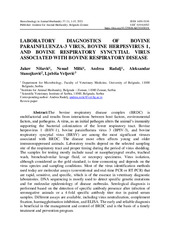Laboratory diagnostics of bovine parainfluenza-3 virus, bovine herpesvirus 1, and bovine respiratory syncytial virus associated with bovine respiratory disease
Laboratorijska dijagnostika virusa parainfluence 3 goveda, goveđeg herpesvirusa 1 i goveđeg respiratornog sincicijalnog virusa kao uzročnika respiratornog sindroma goveda
| dc.creator | Nišavić, Jakov | |
| dc.creator | Milić, Nenad | |
| dc.creator | Radalj, Andrea | |
| dc.creator | Stanojković, Aleksandar | |
| dc.creator | Veljović, Ljubiša | |
| dc.date.accessioned | 2021-12-05T20:42:21Z | |
| dc.date.available | 2021-12-05T20:42:21Z | |
| dc.date.issued | 2021 | |
| dc.identifier.issn | 1450-9156 | |
| dc.identifier.uri | https://vet-erinar.vet.bg.ac.rs/handle/123456789/2260 | |
| dc.description.abstract | The bovine respiratory disease complex (BRDC) is multifactorial and results from interactions between host factors, environmental factors, and pathogens. A virus, as an initial pathogen alters the animal’s immunity supporting the bacterial colonization of the lower respiratory tract. Bovine herpesvirus 1 (BHV-1), bovine parainfluenza virus 3 (BPIV-3), and bovine respiratory syncytial virus (BRSV) are among the most significant viruses associated with BRDC. The disease most often affects young and older immunosuppressed animals. Laboratory results depend on the selected sampling site of the respiratory tract and proper timing during the period of virus shedding. The samples for testing mostly include nasal or nasopharyngeal swabs, tracheal wash, bronchoalveolar lavage fluid, or necropsy specimens. Virus isolation, although considered as the gold standard, is time-consuming and depends on the virus species and sampling conditions. Most of the virus identification methods used today are molecular assays (conventional and real-time PCR or RT-PCR) that are rapid, sensitive, and specific, which is of the essence in veterinary diagnostic laboratories. DNA sequencing is mostly used to detect specific genetic mutations and for molecular epidemiology of disease outbreaks. Serological diagnosis is performed based on the detection of specific antibody presence after infection of seronegative animals or a 4-fold specific antibody titer rise in paired serum samples. Different assays are available, including virus neutralization, complement fixation, haemagglutination inhibition, and ELISA. The early and reliable diagnosis is beneficial in the management and control of BRDC and is the basis of a timely treatment and prevention program. | sr |
| dc.language.iso | en | sr |
| dc.publisher | Belgrade : Institute for Animal Husbandry | sr |
| dc.relation | info:eu-repo/grantAgreement/MESTD/inst-2020/200143/RS// | sr |
| dc.rights | openAccess | sr |
| dc.rights.uri | https://creativecommons.org/licenses/by/4.0/ | |
| dc.source | Biotechnology in Animal Husbandry | sr |
| dc.subject | BRDC | sr |
| dc.subject | BHV-1 | sr |
| dc.subject | BPIV-3 | sr |
| dc.subject | BRSV | sr |
| dc.subject | laboratory diagnosis | sr |
| dc.title | Laboratory diagnostics of bovine parainfluenza-3 virus, bovine herpesvirus 1, and bovine respiratory syncytial virus associated with bovine respiratory disease | sr |
| dc.title | Laboratorijska dijagnostika virusa parainfluence 3 goveda, goveđeg herpesvirusa 1 i goveđeg respiratornog sincicijalnog virusa kao uzročnika respiratornog sindroma goveda | sr |
| dc.type | article | sr |
| dc.rights.license | BY | sr |
| dc.citation.volume | 37 | |
| dc.citation.issue | 1 | |
| dc.citation.spage | 1 | |
| dc.citation.epage | 15 | |
| dc.citation.rank | M24 | |
| dc.identifier.doi | 10.2298/BAH2101001N | |
| dc.identifier.fulltext | http://veterinar.vet.bg.ac.rs/bitstream/id/6233/bitstream_6233.pdf | |
| dc.type.version | publishedVersion | sr |

